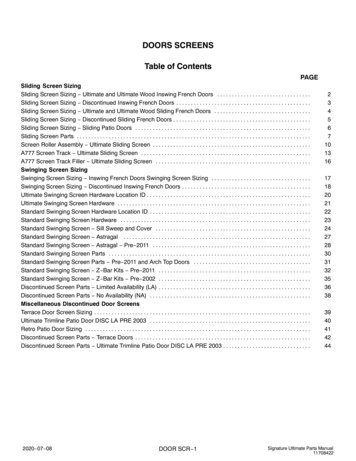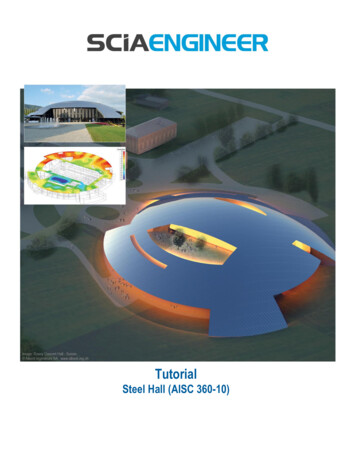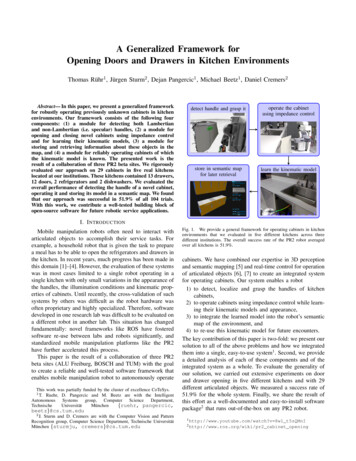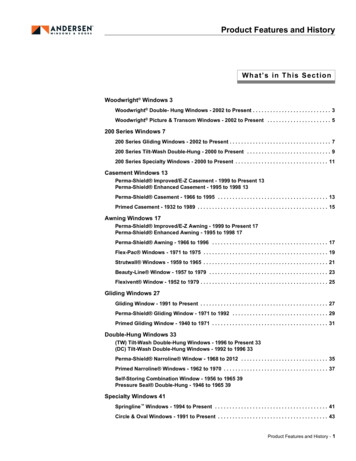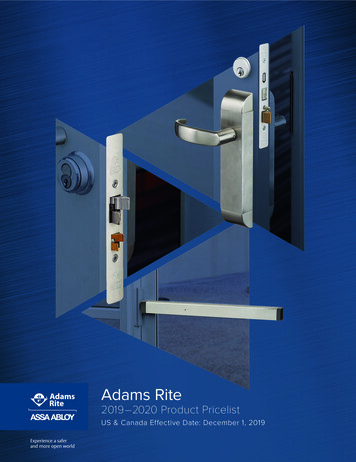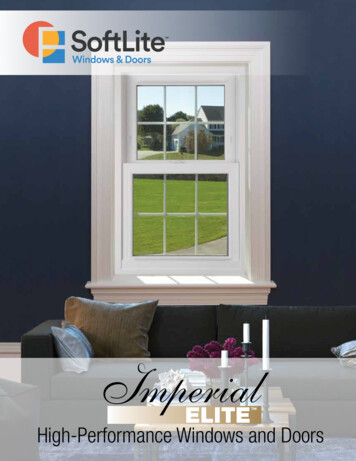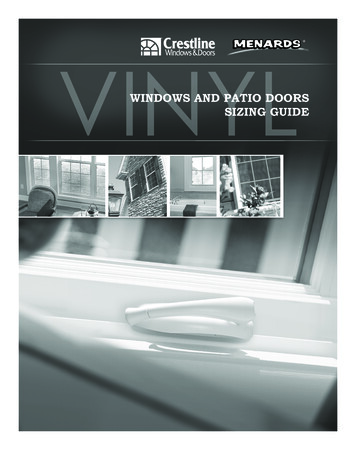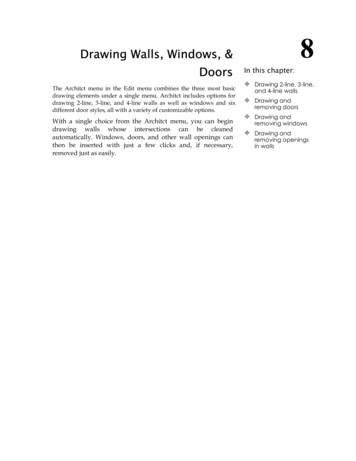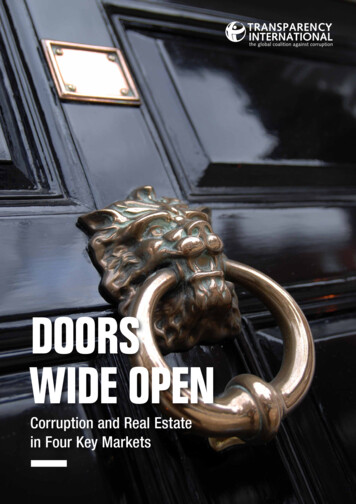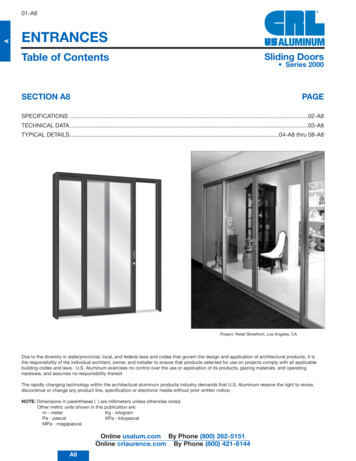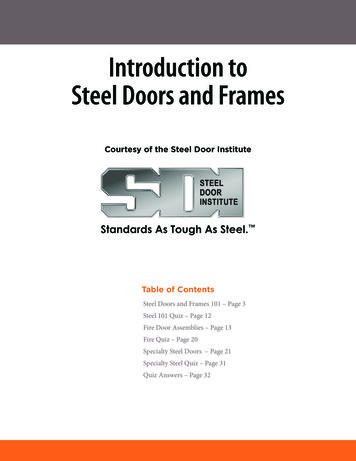
Transcription
Introduction toSteel Doors and FramesCourtesy of the Steel Door InstituteTable of ContentsSteel Doors and Frames 101 – Page 3Steel 101 Quiz – Page 12Fire Door Assemblies – Page 13Fire Quiz – Page 20Specialty Steel Doors – Page 21Specialty Steel Quiz – Page 31Quiz Answers – Page 32
Steel Doors and Frames 101IntroductionSteel is very strong, and in its unaltered state, can withstand significantnatural and man-made abuse. Properly installed and maintained hollowmetal doors often last 30 years or longer. When repairs are necessary,they typically occur in the field at relatively low cost. Steel doors have alow total cost of ownership compared to other door materials.You may hear these doors and frames referred to as “steel” or “hollowmetal”. Generally, architects refer to them as “steel” and distributorsand manufacturers say “hollow metal”. Please note that they arereferencing the same product and the terminology may be usedinterchangeably.Anatomy of a Door OpeningHead (header)The horizontal member which forms the top of a frameHinge jambThe vertical frame member prepared for hinges or pivotsStrike jambThe vertical frame member prepared for a strikeLightA glazed openingDoor faceThe exposed surface of the door not including the verticaledges and top and bottomLock setThe hardware and components that make up the lockingor latching mechanism on a doorStrike plateA metal plate affixed to a doorjamb with a hole or holes for the bolt of the door. When the door is closed,the bolt extends into the hole in the strike plate and holds the door closed.CoreThe material(s) in a hollow metal door or panel3
Steel Doors and Frames 101Fire Rated Doors and FramesFire rated doors and frames play a vital role in keeping peoplesafe and minimizing property damage during a fire. In fact, therehas never been a loss of life from a fire in a building with properlyinstalled and maintained fire doors.Fire doors must meet the requirements of the International Buildingand International Fire Code, as well as NFPA 80 Standard for FireDoors and Other Opening Protectives. Fire ratings range from 20minutes to 3 hours. Hollow metal is the only door material widelyavailable with a 3 hour label.If the wall is fire rated, the frame and door must be fire rated as well.In the event of a fire, temperature rise doors minimize the heattransfer to the non-fire side of the door so people can safely escapefrom a burning building. These doors are built with a specificallydesigned core and are commonly found in the stairwells of high risebuildings.Americans with Disabilities Act (ADA)The Americans with Disabilities Act (ADA) ensures building access to people with disabilities, of whichdoors play an important role. ADA requirements for doors in “places of public accommodation” touch on avariety of characteristics, including:Minimum HeightOpening ForceClosing SpeedHardwareGlasslight LocationMinimum Door WidthMinimum Maneuvering ClearancesThreshold4
Steel Doors and Frames 101Types of FramesFrame profiles are generally either masonry/flush frames or slip-on drywall frames. The two most commontypes of frames and elevations are knock down (KD) and welded. KD frames come in pieces. The frame isthen assembled and installed into an opening. Welded frames are manufactured and delivered in one piece.They are set in place and then the masonry is built around the welded frames.KD Drywall FramesStandard KD FramesAlso called KD pressure-fit or slip-ondrywall frames, these frames are specified forinstallation in existing drywall openings. Theyare shipped disassembled, use compressionanchors, and have interlocking tabs and slots inthe corners.Standard KD frames are specified for newwall construction. They generally have slotsand tabs, but use standard anchors instead ofcompression anchors.Face Welded FramesContinuously Welded FramesThe most common type of welded frame. Thejoints between the head and jamb faces havea continuous weld on the visible side of bothfaces only. Frames are shipped assembled.Also called full profile welded or fully welded.The comer/perimeter joints have all elementsof the frame member continuously weldedincluding soffits, stops, rabbet, faces, andreturns.5
Steel Doors and Frames 101Frame ProfileFaceExposed part of the frameThroatOpening between the backbends of the frameJamb depthOverall width of frame profile—face to face dimensionStopPart of frame door the closes againstRabbetThe area on either side of the soffit, available in a single or double rabbet designSoffitThe area between the rabbets6
Steel Doors and Frames 101The Frame OpeningNominal openingThe distance measured between the frame. Thenet opening is the measurement of the door slab.UndercutClearance between the bottom of the frame andthe doorDoor width and door heightMeasurements of the width and height inside ofthe frame, less the clearanceAnchoringAnchors are used to affix the frame to the wall. The typeof anchor depends on the wall, generally either stud ormasonry.There are a variety of stud wall anchors that arespecific to each wall type. They are often shippedloose with the frames or can be welded into the jambs.Masonry wire anchors are installed in masonry framesas the wall is built and can be resized to match the jambdepth of the frame as needed.Note - Altering anchoring methods maynegate the fire rating of the opening.7
Steel Doors and Frames 101ElevationsThere are endless frame possibilities.Sidelights are physically connected to theside of the door. Transoms are an overheadlight or panel. Many frames have more thanone type of elevation. This school entrancehas sidelights and transoms, plus the doorshave vision panels.Performance Levelsof DoorsArchitects will stipulate theperformance level in theirspecifications. ANSI/SDI A250.8- Specifications for Standard SteelDoors and Frames assigns doorperformance levels from 1-4. Thegauge of steel is thicker with eachlevel, and the heavier duty the door,the more it costs and weighs.ThicknessInchesmmManufacturersStandard Gauge1 - Standard Duty0.0421.0182 - Heavy Duty0.0531.3163 - Extra Heavy Duty0.0531.3164 - Maximum Duty0.0671.714LevelLevel one doors are standard dutyand are designed for applications with minimal wear and tear, such as an interior office door.Level four doors are maximum duty and are built for abusive environments or where security is imperative.Door SelectionThere is a Door Selector Tool on the SDI website that recommendsdoor performance levels based on the location of the opening (ie.school gymnasium, office stairwell, etc.). Just visit steeldoor.org andclick “Door Selector” in the main menu.8
Steel Doors and Frames 101Door CoresHoneycomb coreHollow metal door manufacturers use a variety of corematerials to meet the desired performance levels.HoneycombModerate sound reduction, minimal insulationPolystyreneModerate insulation, minimal sound reductionPolyurethaneHigh insulation, minimal sound reductionMineralUsed for temperature rise doors, which reduce the heating ofthe “cool” side of the doorSteel Stiffened with Fiberglass InsulationWithstands abuse and high usage; good sound resistanceHoneycomb coreThese are the most common core materials, howeverhollow metal door manufacturers have proprietary coresas well, particularly for high performance products.Galvannealed vs. Galvanized SteelHollow metal doors and frames are generally made with galvannealed steel, not galvanized steel.Galvanized steel has that spangled look and is often found in coating weights of G40, G60, and we’ve seenspecs with up to G90. The issue with these “G” coatings is that primer doesn’t stick very well to them so ithinders the protection of the steel doors. Although sometimes specified and manufactured, the Steel DoorInstitute does not recommend the G Type zinc coating for doors and frames.Galvannealed steel is still zinc coated – without the spangled look – and is generally coated at A40 orA60. A40 is the minimum recommended weight, while A60 offers better corrosion protection. It is notrecommended to go higher than A60 because it reduces paint adhesion. Galvannealed steel is also knownas “paintlok” for its excellent paint adhesion, which is why it is by far the most common type of steel used inhollow metal doors and frames.Galvannealed steelGalvanized steel9
Steel Doors and Frames 101Hardware ReinforcementYou’ve probably experienced the frustration of a door thatdoesn’t operate properly. Maybe it was sagging, or perhaps thehardware was loose and falling off. While the initial reactionmay be to blame the quality of the door or hardware, themajority of these issues are due to poor installation. Despitethe manufacturers not being at fault for improper fieldinstallation, their reputations are still on the line.The Steel Door Institute created ANSI/SDI A250.6Recommended Practice for Hardware Reinforcing onStandard Steel Doors and Frames as a guide to doorreinforcement and the installation of door hardware. It shouldbe referenced by hollow metal door installers.The correct hardware must be selected to ensure the doorand frame are properly reinforced. Screws must have threethreads within the door to effectively secure the hardware.A level two 18 gauge door is only thick enough for twothreads, therefore the door must be reinforced per ANSI/SDIA250.6.The Risks of Grouting FramesThere are more risks than rewards when grouting frames. Some specifiers orcontractors prefer grouted frames because they incorrectly believe it improvesthe structural integrity. While grout can improve the sound deadeningqualities of a frame, a properly anchored frame will not be any sturdier if it isgrouted.Grouting should never be specified for drywall construction. When the groutis drying, the moisture can either go into the drywall (weakening it) or intothe frame or hardware (causing rust).Grouting is generally unnecessary for masonry construction as well. To beclear, if the grouting is done properly it will not cause any issues with theframe. Unfortunately, thin pumpable slurry is often used and its excess watercauses rust. If grouting is requested, it should always be hand troweled andnever pumped.10
Steel Doors and Frames 101AppearanceSteel doors are available in a variety of finishes andconstructions. Some manufacturers offer to finish paint themfor the customer. They are also available in stainless steel fora modern look, with a faux wood grain finish, or embossedwhere a decorative opening is desired. Embossed doors canrange from a single panel (see image) up to eight or morepanels. These doors can achieve a three hour fire rating, justlike other steel doors.These are the most common core materials, howeverhollow metal door manufacturers have proprietary coresas well,\particularly for high performance products.Steel is GreenSteel is the most recycled material in North America. It is an infinitely recyclable material due to itsinherent durability. Most other materials degrade in the recycling process and must be discarded after onlybeing recycled once or twice.Steel is North America’s #1Recycled Aluminum166,094Glass113,016Plastic85,213*Data from 2015The “green” nature of steel allows it to contribute LEED points. In 2018, the Steel Door Institute completedthe first industry-wide, LEED-compliant Environmental Product Declarations (EPDs) for steel doors. Thiswas achieved by undergoing a “cradle-to-gate” assessment for two products: (1) heavy duty flush panelsteel doors made with a polystyrene core and (2) 5-3/4” 16-gauge steel prime painted door frames. AllSteel Door Institute member manufacturers offer these products, which can contribute toward the LEED v4Materials and Resources category, “Building Product Disclosures and Optimization”.11
Steel Doors and Frames 101Steel Doors and Frames 101 Quiz1. The distance measured between the frame is the opening.a.b.c.d.NetGrossNominalPractical2. What is the highest commonly available fire rating for a door?a.b.c.d.20 minutes45 minutes1 hour3 hours3. Which type of door retards the transmission of heat through the door?a.b.c.d.Temperature drop doorsTemperature rise doorsDouble insulated doorsNone of the above4. Masonry frames are installed after the wall is built.a. Trueb. False5. Architects should stipulate the doors’ performance level in their specs. ANSI/SDIA250.8 states that Level 1 is standard duty. Which level is for maximum duty?a.b.c.d.23456. Which gauge of steel is thicker?a. 20 gaugeb. 14 gauge7. Steel doors are generally prime painted with a rust-inhibiting primer.a. Trueb. False8. Which type of steel is preferred for steel doors and frames due to betterpaint adhesion?a. Galvanizedb. GalvannealedQuiz answers are on page 32.12
Fire Rated Door AssembliesThere’s a lot to learn when it comes to fire rated products. This sectionof Introduction to Steel Doors and Frames covers the fundamentals.Fire rated doors and frames play a vital role in keeping people safeand minimizing property damage. They are proven to prevent fire fromspreading from one area to another, which also allows the occupantsto safely evacuate. Here is just one example of how fire doors can savelives.Here’s an example of how a closed fire door protected the Robert MosesNature Center from a fire that started in the workshop.Photos courtesy ofFire Protection Specialist Christopher TaylorNYS Office of Fire Prevention and Control13
Fire Rated Door AssembliesFire doors must be closed and latched to provide protection. Duringa fire, smoke would enter the stairwell through this open door andhinder the occupant’s ability to evacuate. The barrel is also partiallyblocking the stairwell walkway and could be an obstacle during amass evacuation.An active latchbolt is required for each fire door to keep the doorlatched during a fire.These are the most common core materials, howeverhollow metal door manufacturers have proprietary coresas well,particularly for high performance products.Common
Fire doors must meet the requirements of the International Building and International Fire Code, as well as NFPA 80 Standard for Fire Doors and Other Opening Protectives. Fire ratings range from 20 minutes to 3 hours. Hollow metal is the only door material widely available with a 3 hour label. If the wall is fire rated, the frame and door must be fire rated as well. In the event of a fire .
